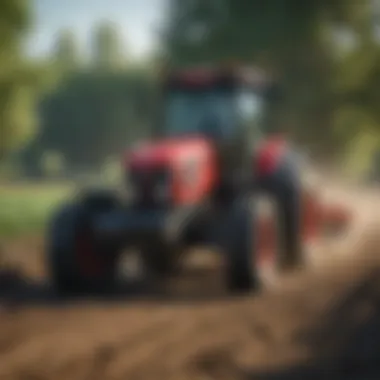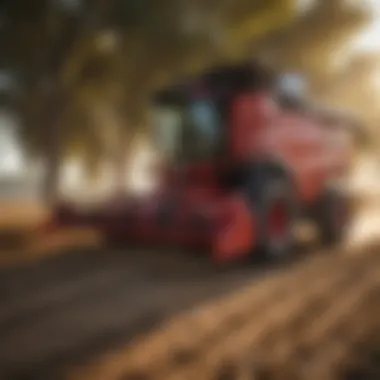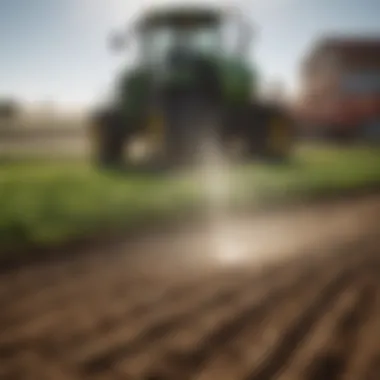Exploring Top Heavy Equipment for Agricultural Innovation


Intro
Agriculture is a vital sector that feeds the growing population worldwide. To keep pace with increasing demands, heavy equipment plays a crucial role in enhancing efficiency and productivity in farming. The choice of machinery can significantly influence sustainability and operational success. This article provides an in-depth look into heavy equipment applicable in agricultural innovation. Readers can expect insights into various machines, their applications, and how technological advancements shape modern farming practices.
Topic Overview
Definition and Importance
Heavy equipment in agriculture refers to large machinery specifically designed for various farming activities, such as plowing, planting, and harvesting. These machines are essential for improving productivity and efficiency. Their importance lies in the ability to process larger areas of land in a shorter period, reducing labor costs and increasing crop yields. Moreover, they can introduce precision into farming, enhancing resource allocation and minimizing waste.
Brief History and Evolution
The history of agricultural machinery dates back to the early 19th century. Early innovations included the seed drill invented by Jethro Tull, which advanced planting techniques. The introduction of tractors in the early 20th century marked a turning point, offering farmers a reliable power source. Over the decades, technology has evolved, leading to the development of sophisticated machines like combine harvesters and precision planters. Today, GPS-enabled equipment and autonomous vehicles represent the forefront of this evolution, embodying the ongoing quest for efficiency and sustainability in agriculture.
Key Techniques and Innovations
Sustainable Farming Practices
Sustainability is a growing focus in agriculture. Equipment is being designed with eco-friendly practices in mind. For instance, no-till planting systems reduce soil erosion and improve soil health, while precision application technologies ensure fertilizers and pesticides are used judiciously. Tractors equipped with GPS technology can optimize planting patterns, reducing the likelihood of over-application.
Advanced Agronomic Technologies
Modern heavy equipment integrates cutting-edge technology. Autonomous tractors operate with minimal human intervention, allowing farmers to work on multiple fields simultaneously. Drones provide aerial imagery to assess crop health, helping to inform decisions on water and nutrient management. Ultimately, these technologies not only boost productivity but also contribute to more sustainable farming practices.
Practical Applications
Step-by-Step Guides
To select the best heavy equipment for specific tasks, farmers must first assess their operational needs:
- Identify tasks: Determine whether you need machinery for planting, cultivating, or harvesting.
- Evaluate land size: Larger plots may require equipment with higher capacity, such as larger tractors or combines.
- Consider technology: Equipment with advanced features can enhance efficacy but may require additional investment.
- Budgeting: Establish your budget to balance between necessity and efficiency.
- Research brands: Compare products from well-known manufacturers like John Deere or Case IH to find the best fit.
Case Studies or Real-World Examples
Several farmers have successfully incorporated heavy equipment to optimize their practices:
- A corn farmer in Iowa implemented precision farming technology, resulting in a 20% increase in yield.
- A vineyard owner in California adopted a combination of automated tractors and drones, improving labor efficiency and reducing overall costs by 15%.
- An organic farm used no-till planters to enhance soil health, leading to healthier crops and higher market prices.
These examples demonstrate the tangible benefits that can result from thoughtful investment in quality heavy equipment.
End
Understanding the available heavy equipment options and their applications is critical for farmers aiming to enhance productivity and sustainability. By staying informed about innovations and best practices, you can make educated decisions that benefit both your crops and the environment.
Understanding Heavy Equipment in Agriculture
Agriculture operates on a foundation of efficiency, precision, and resilience. Heavy equipment plays a vital role in achieving these goals. Understanding heavy equipment involves recognizing its contributions to modern agricultural practices. Without it, operations would become laborious and time-consuming, affecting productivity. The machinery in this sector not only facilitates large-scale farming but also enhances sustainability efforts.
Definition and Importance
Heavy equipment, in an agricultural context, refers to powerful machinery designed for various farming tasks. This includes tractors, harvesters, and plows among others. The importance of this equipment cannot be overstated. It allows farmers to perform large tasks with minimal labor. This efficiency leads to increased crop yields and reduced operational costs. Furthermore, as agriculture faces challenges from climate change, integrating advanced equipment becomes essential. The role of heavy equipment evolves as it adapts to these new ecological demands. It must meet both economic and environmental goals, ensuring food security for an ever-growing population.
Key Characteristics of Heavy Equipment
Heavy equipment features certain characteristics that make it indispensable in agriculture. Here are some notable aspects:
- Durability: These machines are built to withstand harsh conditions. Farmers often work in unpredictable weather and tough terrains, so equipment must be resilient.
- Performance: High-powered engines offer the necessary force for extensive operations. When choosing equipment, performance must align with the specific task.
- Versatility: Many heavy machines can perform multiple functions. For example, a tractor can be utilized for plowing, harvesting, and transporting goods.
- Technology Integration: Modern equipment incorporates technology to boost productivity. Features like GPS tracking and automation enhance operational precision.
Categories of Heavy Equipment
The categorization of heavy equipment is fundamental for understanding its vast applications in agriculture. These categories enable farmers and agricultural enthusiasts to pinpoint the exact machinery that fits their specific needs. Moreover, selecting the right category can lead to improved efficiency, optimized resource use, and enhanced sustainability practices. Each type of equipment serves a distinct purpose, ultimately impacting the productivity of agricultural operations. By exploring the various categories of heavy equipment, one gains insights into how to leverage these machines for better yield and operational effectiveness.
Tractors


Tractors are often referred to as the backbone of any agricultural operation. They provide the necessary power to pull multiple implements, making them versatile for various tasks. Modern tractors come equipped with advanced features, including GPS technology and fuel-efficient engines. This not only boosts productivity but also reduces operational costs. Tractors can be used for plowing, tilling, and hauling goods. Thus, their multifunctional nature makes them indispensable in farming practices.
Harvesters
Harvesters significantly enhance productivity during the crucial harvest period. These machines can efficiently gather crops from vast fields, minimizing labor costs and time. Combining various functionalities, such as cutting, threshing, and gathering, harvesters streamline the harvesting process. Using modern equipment like John Deere and Case IH harvesters brings precision and speed to crop collection, ensuring that produce is gathered at the optimal time for quality retention.
Plows and Tillage Equipment
Plows and tillage equipment play a critical role in soil preparation. These tools break up and aerate the soil, facilitating good seed-to-soil contact for better germination. With options for different soil types and crop requirements, choosing the right plowing equipment is essential. Notably, tillage impacts soil health, water retention, and nutrient availability. Therefore, understanding the specific needs of the agricultural land helps farmers make informed decisions about which tillage methods to adopt.
Spreaders and Sprayers
Spreaders and sprayers are essential for applying fertilizers and pesticides effectively. This equipment allows farmers to achieve even distribution of nutrients or pest control substances over large areas. Precision cleaning and application equipped machines can lead to reduced waste and improved yield quality. Implementing these machines with technologies like variable rate application allows for more sustainable farming, optimizing input costs while protecting the environment.
Loaders and Material Handling Equipment
Loaders and material handling equipment facilitate the management of inputs and outputs on a farm. From moving soil to transporting bales of hay, these machines are crucial for efficiency. They help in managing logistics, ensuring that resources are in the right place at the right time. The versatility of loaders allows them to be equipped with various attachments, making them suitable for different tasks across the farm.
In summary, recognizing the various categories of heavy equipment is key to implementing effective agricultural practices. Each category serves distinct yet crucial roles, helping to drive productivity and sustainability in farming operations.
Top Heavy Equipment Brands
The selection of heavy equipment brands is pivotal in the agricultural sector. Each brand offers unique characteristics, technological advancements, and adaptability to various farming tasks. By understanding the reputation and offerings of these brands, farmers can make informed decisions. It ensures the investment contributes to productivity, efficiency, and sustainability in farming practices. Additionally, brand reliability ties closely to resale value and long-term support. This aspect is crucial for farmers considering both immediate needs and future planning.
John Deere
John Deere stands as a preeminent name in agricultural machinery. The brand embodies innovation, quality, and reliability. Its range includes tractors, harvesters, and tillage equipment tailored for diverse farming operations. Notably, the Green Star technology enhances precision farming by providing data-driven insights. This empowers farmers to optimize inputs and improve yields.
Another significant advantage of John Deere equipment is their service network. Farmers benefit from extensive support, ensuring minimal downtime. Additionally, the resale value of John Deere machinery remains high, making it a wise long-term investment.
Caterpillar
Caterpillar is not solely focused on agriculture but does offer formidable machinery for heavy-duty tasks. Known for robust construction and durability, Caterpillar’s loaders and excavators support large-scale farming operations effectively. For instance, their D-series bulldozers are adept at land clearing and preparation.
The incorporation of technology also distinguishes Caterpillar. Their advanced telematics solutions provide real-time machine data, aiding farmers in maintenance and operational efficiency. This blend of strength and technology makes Caterpillar a trusted choice for farmers with intensive operations.
Case IH
Case IH is synonymous with innovation in the agricultural landscape. The brand emphasizes enhancing productivity through various equipment, including the Axial-Flow combine harvesters, renowned for their efficiency and ease of use. These machines help farmers maximize output with minimal labor.
Moreover, Case IH places a strong emphasis on sustainability. Their equipment supports precision farming practices, which align with modern ecological demands. This brand encourages farmers to adopt practices that reduce environmental impact while maintaining profitability.
Kubota
Kubota specializes in compact and mid-sized heavy equipment, catering primarily to small and medium-sized farms. Their tractors and implements are versatile, supporting a wide range of tasks from tilling to harvesting. Kubota's BX Series tractors are particularly appealing due to their accessibility and ease of operation.
The brand is also recognized for its commitment to innovation. Kubota integrates new technologies to enhance operator comfort and efficiency. Their machinery often combines traditional usability with modern advancements, appealing to a diverse audience in agriculture.
New Holland
New Holland is a well-respected brand offering a comprehensive range of agricultural machinery. The brand's reputation for quality is matched by its commitment to sustainability. New Holland's Clean Energy Leader initiative emphasizes environmentally friendly practices in machine design, making them a favorite among farmers dedicated to responsible farming.
Their tractors, harvesters, and applications for precision agriculture allow for flexibility in farming operations. Moreover, New Holland places strong importance on user-friendly designs, which enhances the overall operator experience.
"Selecting the right heavy equipment brand impacts not just productivity, but the sustainability of farming practices as well."
In summary, understanding the top heavy equipment brands provides a framework for making informed decisions in the agricultural sector. Evaluating options based on features, technology, reliability, and support can significantly enhance operational outcomes.
Technological Advancements in Heavy Equipment
In today's agricultural landscape, technological advancements in heavy equipment play a pivotal role. These innovations are not mere enhancements but foundational shifts that redefine efficiency, productivity, and sustainability. They allow farmers to respond to increasingly complex challenges in agriculture with lasting solutions. As the demands on modern farming increase, these advancements ensure that heavy equipment remains relevant and effective.
Precision Agriculture
Precision agriculture represents a significant leap in agricultural technology. This approach utilizes advanced technologies like GPS, IoT devices, and real-time data analytics to optimize field-level management. Farmers can monitor crop health and resource use with high precision, which leads to the reduction of waste.


The benefits of precision agriculture are manifold:
- Increased Efficiency: Equipment can be directed to where it is needed most, conserving resources such as water and fertilizers.
- Higher Yield: By targeting specific areas for treatment, farmers can achieve better crop yields while minimizing environmental impact.
- Cost Reduction: Precision tools allow for more controlled application of inputs, reducing overall operational costs over time.
The integration of precision agriculture into heavy equipment is essential for farmers aiming to enhance productivity while practicing sustainable farming.
Automation and Robotics
Automation and robotics are reshaping how agriculture operates. With the introduction of autonomous tractors, drones, and robotic harvesters, the modern farmer is empowered to conduct tasks that were once labor-intensive and time-consuming.
Some key advantages include:
- Labor Savings: Automated systems reduce reliance on human labor, which can be a scarce resource in many areas.
- Consistency and Precision: Machines deliver uniform results, reducing the risk of human error.
- Data Collection: Many automated systems collect valuable data, providing insights that can be used to improve future operations.
The evolution of robotics in heavy equipment not only boosts productivity but also opens new avenues for innovative farming practices.
Sustainable Practices
Sustainable practices in agriculture are crucial for long-term viability. Heavy equipment now incorporates designs and technologies that promote sustainability. This includes fuel-efficient engines, reduced emissions, and innovations in mechanization that decrease soil compaction.
The importance of sustainable practices in heavy equipment includes:
- Environmental Protection: Equipment that minimizes chemical runoff and cuts down on fossil fuel use directly benefits ecosystems.
- Economic Viability: Sustainable choices often lead to lower operating costs and increase profitability.
- Consumer Demand: As consumers lean toward environmentally friendly products, farmers employing sustainable practices are better positioned in the market.
"Sustainable heavy equipment not only supports productive farming but also aligns with global initiatives for environmental preservation."
Economic Considerations in Heavy Equipment Investment
The economic aspects of heavy equipment investment are critical for agricultural businesses. Investing in machinery is not just about initial costs; several layers of financial implications exist that can shape the overall profitability of a farm operation. Understanding these elements enhances the efficiency of farmers in both short-term and long-term planning.
Cost of Ownership
Cost of ownership encompasses more than just the purchase price of heavy equipment. It includes expenses such as maintenance, insurance, fuel, and any depreciation over time. Farmers must consider the total cost of ownership to ensure they do not overspend. For example, a tractor may seem affordable initially but might require significant upkeep and fuel consumption, increasing its annual cost substantially.
- Maintenance Costs: Regular maintenance, though essential, can be a financial burden. Equipment should be regularly serviced to prevent breakdowns that could lead to costly repairs.
- Insurance: Insuring heavy equipment protects farmers from potential damages or theft, but it adds to the annual expenditure.
- Fuel Efficiency: Equipment that consumes less fuel may have a higher upfront cost but offers savings over time.
Farmers need to take all these into account to evaluate their overall budget effectively.
Financing Options
Securing financing for heavy equipment can make or break a farmer's ability to invest. Different financing methods can affect cash flow and budgeting strategy. Some common options include:
- Loans: Traditional bank loans might offer lower interest rates but require good credit histories.
- Leasing: Leasing equipment can be advantageous for newer farmers who may not have large capital upfront. It allows access to advanced machinery without permanent commitment.
- Government Programs: Many governments provide subsidies or grants for farmers investing in modern equipment. This can make high-tech machinery more affordable.
Understanding the right financing option is crucial. Investing in faster or more efficient machinery could result in higher production rates, ensuring better returns in the long term.
Resale Value
The potential resale value of heavy equipment is often overlooked when purchasing. As with all investments, the ability to recoup costs through resale can significantly impact return on investment.
Factors that affect resale value include:
- Brand Reputation: Well-known brands like John Deere or Kubota typically hold their value better due to their reliability.
- Condition: Proper maintenance will enhance the resale value, as it indicates the equipment's reliability.
- Market Demand: Some models may become more desirable than others over time based on technological advancements or changing market needs.
A well-informed purchase strategy should account for future value. Farmers should research typical resale values of desired equipment models before making a decision.
Overall, weighing economic considerations is essential for adopting heavy equipment in agriculture. Understanding the costs associated, financing options, and potential resale value can guide farmers in making strategic decisions that enhance productivity and sustainability.
Selecting the Right Heavy Equipment
Choosing the right heavy equipment in agriculture is crucial. This decision impacts productivity, efficiency, and ultimately the farm's profitability. The market offers a wide range of options tailored for diverse agricultural tasks. Therefore, understanding how to select the best equipment is important for farmers and those in the agricultural sector.
Assessing Agricultural Needs
Identifying specific agricultural needs is the first step in selecting heavy equipment. Each farming operation is unique. Factors such as crop type, field size, and terrain play a major role in determining the appropriate machinery. Livestock farms will require different equipment compared to crop-focused farms.


Before making any decisions, farmers should conduct a thorough analysis of what tasks the equipment needs to perform. For instance, a farm focusing on large acreage might prioritize tractors with high horsepower and capacity.
Consider the following factors:
- Crop Type: Different crops have specific needs. For example, blueberries may require specialized harvesters, while corn might need a combine.
- Field Conditions: Equipment that performs well in flat terrains may struggle in hilly areas. Understanding the landscape helps in making the right choice.
- Workload: Anticipating the workload for peak seasons aids in selecting machines that can handle demands without downtime.
Evaluating Equipment Features
Next, evaluating the equipment features themselves becomes essential. When choosing heavy machinery, look for specifications that align with the agricultural needs identified earlier. Key features may include:
- Power and Efficiency: The power of the equipment must meet the tasks it will handle. Efficient fuel consumption adds to long-term savings.
- Versatility: Multi-purpose machines can save money. For example, some tractors can switch attachments for various tasks.
- Technological Integration: Advanced features such as GPS and automated controls provide precision and help in minimizing waste.
Comparing models and brands increases understanding of available technology. Each manufacturer may have different features that appeal to specific agricultural tasks.
Considering Maintenance and Support
Ongoing maintenance and support are vital but often overlooked. Heavy equipment requires regular upkeep to ensure longevity and performance. Consider the following:
- Service Availability: Is there a dealer nearby? Local support makes maintenance easier.
- Parts Accessibility: The availability of spare parts is crucial for minimizing downtime.
- Warranty and Service Plans: Good warranties and service plans protect investments and ensure farmers can receive assistance when needed.
Farmers should also create a maintenance schedule. Regular checks can prevent minor issues from escalating into costly repairs. Investing time in planning maintenance can lead to more productive farming.
"Selecting the correct heavy equipment can transform farm operations, enhancing both productivity and sustainability."
By carefully assessing agricultural needs, evaluating equipment features, and considering maintenance, farmers can make informed decisions that positively impact their operations. This thoughtful approach to selection ensures that investments in heavy equipment yield significant returns.
Challenges in Heavy Equipment Usage
Heavy equipment plays a crucial role in modern agriculture. However, its usage comes with various challenges that farmers and operators must navigate. Understanding these challenges is essential. It may help practitioners make informed decisions when selecting and maintaining equipment, ultimately enhancing productivity.
Maintenance Requirements
Regular maintenance is fundamental to the longevity and efficiency of heavy equipment. These machines endure rigorous use, especially during peak farming seasons. Neglecting maintenance can lead to significant breakdowns, which impact productivity and increase costs.
Farmers should establish a routine maintenance schedule. This includes changing oil, inspecting hydraulic systems, and checking essential components. Regularly servicing heavy equipment reduces unexpected downtimes. It is also critical for safety, as faulty equipment can lead to accidents.
Furthermore, investing in proper maintenance tools can pay off in the long term. Training personnel on basic maintenance practices can also empower operators to tackle minor issues before they escalate.
Skill Level of Operators
The skill level of operators is another critical factor influencing the efficiency of heavy equipment. Highly skilled operators can maximize the potential of their machinery, ensuring they achieve desired outcomes safely and effectively.
Training programs should be implemented to enhance skill levels. These programs are necessary not only for new operators but also for seasoned ones. Technology in heavy equipment is continually evolving, meaning even experienced operators must adapt to new tools and systems.
Inadequate training can lead to misuse of equipment, which may result in damage or accidents. Therefore, investing in comprehensive training can minimize risks and improve operational efficiency. Well-trained operators contribute to better crop yields and efficient resource utilization.
Investing in operator training significantly impacts the overall performance of heavy equipment in agriculture.
To sum it up, recognizing and addressing the challenges in heavy equipment usage is vital. Addressing maintenance needs and enhancing operator skills can lead to improved productivity and safety in agricultural practices.
Future of Heavy Equipment in Agriculture
The future of heavy equipment in agriculture is a pivotal area of discussion. As the industry faces numerous challenges, the evolution of machinery is one of the primary tools to enhance productivity and ensure sustainability. Innovations will allow farmers to address labor shortages and improve efficiency. The integration of technology plays a significant role in this transition, affecting everything from crop production to livestock management.
Innovations on the Horizon
As technology advances, the agricultural sector will witness several key innovations.
- Autonomous Vehicles: Self-operating tractors and harvesters will become more commonplace. These vehicles can work around-the-clock, increasing productivity without the need for constant human supervision.
- Drones: Drones will be utilized for crop monitoring and surveying. They can provide farmers with real-time data on crop health and soil conditions, allowing for more precise farming practices.
- Data Analytics: Heavy equipment will increasingly rely on big data. By analyzing data from various sources, farmers can make informed decisions about planting, irrigation, and harvesting.
"The integration of autonomous systems in agriculture could radically change the approach to farming, potentially increasing yields and reducing labor costs."
- Smart Sensors: The emergence of smart sensors attached to equipment will assist in evaluating field conditions. These sensors can help optimize the use of resources like water and fertilizers, leading to more sustainable practices.
Impact of Climate Change
With climate change being an ever-present concern, heavy equipment must evolve to adapt. This has multiple implications:
- Adapting to Weather Variability: Machinery will increasingly be designed to handle extreme weather conditions such as floods and droughts. For instance, equipment with better traction and flotation capabilities will be necessary in wetter environments.
- Emission Regulations: Heavy equipment will be required to adhere to stricter emissions standards. Innovation in engine technology, such as electric or hybrid systems, will become more prominent.
- Resource Efficiency: As resources become scarcer due to climate change, farmers will need equipment that maximizes resource efficiency. This means using less water and energy, with a reduced carbon footprint.
In summary, the future of heavy equipment in agriculture promises significant advancements that not only improve efficiency but also help in combating the challenges posed by climate change. As technologies continue to develop, the way farmers operate will be transformed, leading to more innovative and sustainable approaches to agriculture.



